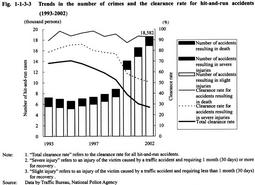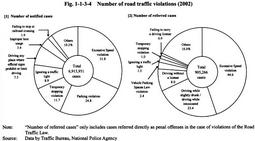| Previous Next Index Image Index Year Selection | |
|
|
1 Trends in traffic offenses (1) Unsafe driving resulting in death or injury and professional negligence in traffic accidents The offense concerning unsafe driving resulting in death or injury was newly established upon the partial amendment to the Penal Code in November 2001 (entry into force in December 2001). Recently, there have been many traffic accidents in which offenders killed or injured people by committing heinous and dangerous driving that defied traffic laws, such as intoxicated driving and excessive speed violations. However, professional negligence resulting in death or bodily injury has not satisfactorily been applicable to such heinous and serious traffic accidents. The offense concerning unsafe driving resulting in death or injury has been established with the aim of regarding the act of killing or injuring people in traffic accidents by such heinous and dangerous driving not as an offense committed by negligence or negligent driving but as an offense committed with the intention of dangerous driving which caused death or injury, and of punishing them as serious offenses corresponding to bodily injury by assault or bodily injury resulting in death.
Fig. 1-1-3-1 shows the trends in the number of traffic accidents and the number of persons killed or injured in traffic accidents since 1946. The number of persons killed in traffic accidents peaked in 1970 and it has been decreased since 1993 in the recent period. On the other hand, the number of traffic accidents increased since 1978, setting an all-time high in 1993. Since then, it continued to hit new highs every year, but it decreased from the previous year in 2002. The number of persons injured in traffic accidents was on the rise, hitting new record highs every year since 1998, but decreased in 2002 from the previous year. The decrease in these numbers seems to be partly due to the fact that the newly established offense concerning unsafe driving resulting in death or injury and tightened regulations under the Road Traffic Law have made the public recognize the importance of observing traffic rules (see Appendix 1-5 ). Fig. 1-1-3-1 Trends in the number of traffic accidents, persons killed or injured in traffic accidents(1946-2002) Fig. 1-1-3-2 shows the trends in the number of persons cleared for unsafe driving resulting in death or injury and professional negligence in traffic accidents over the last 10 years. The total number has increased since 1998, surpassing 800,000 for the first time in the postwar period in 2000. In 2002, it also increased by 0.2% from the previous year to 872,006. On the other hand, the number of persons cleared for unsafe driving resulting in death, professional negligence resulting in death, and (gross) negligence resulting in death gradually decreased, but it has increased by 2.7% from the previous year to 7,123 in 2002.Fig. 1-1-3-2 Trends in the number of persons cleared for unsafe driving resulting in death or injury and professional negligence in traffic accidents (1993-2002) Fig. 1-1-3-3 shows the trends in the number of crimes and clearance rate for "hit-and-run accidents (the intentional failure to declare accidents concerning professional negligence in traffic accidents etc.)" over the last 10 years. The number of crimes increased since 1996 and rose noticeably over the last 3 years. The clearance rate, however, decreased since 1996. In 2002, the clearance rate was 92.7% for cases resulting in death and 50.6% for those resulting in severe injuries, while the total fell to 26.9%.Fig. 1-1-3-3 Trends in the number of crimes and the clearance rate for hit-and-run accidents (1993-2002) (2) Violation of traffic-related law Along with the establishment of the offense concerning unsafe driving resulting in death or injury, the Road Traffic Law was also amended by the Law for Partial Amendment to the Road Traffic Law (Law No. 51 of 2001) to tighten punishments for illegal acts of heinous and dangerous driving, and the amended law entered into force on June 1, 2002.
The total number of road traffic violations decreased every year after peaking at 13,846,532 in 1984, but in 2002, it increased by 0.1 % from the previous year to 7,819,217. Fig. 1-1-3-4 shows the number of road traffic violations. The number of notified cases of non-penal offenses under the traffic violation notification system was 6,913,951 (88.4% of the total number of road traffic violations). By type of violation, the number of excessive speed violations was the largest, followed by stopping-parking violations, and temporary stopping violations. On the other hand, among the cases referred to public prosecutors offices for violations of the Road Traffic Law as penal offenses, excessive speed violations were the most, followed by driving while slightly drunk/intoxicated, and driving without a license. The 3 major violations-drunken driving (driving while slightly drunk/intoxicated), driving without a license, and excessive speed violations-accounted for 76.1 % of the total number of referred cases for penal offenses related to road traffic violation. Fig. 1-1-3-4 Number of road traffic violations (2002) |



